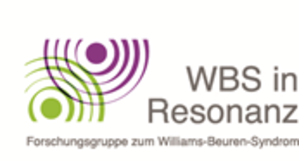


Williams Syndrome
Williams Syndrome (WS) is a rare neurodevelopmental disorder caused by a deletion of ~26 genes on chromosome 7q11.23 (Hillier et al., 2003), which occurs in 1 of 7,500 live births (Strømme, Bjørnstad, & Ramstad, 2002). The WS phenotype is typically associated with moderate intellectual disability, specific “elfin” facial structure and physical anomalies cardiac problems, hyper social behavior, anxieties, and a need for lifelong support (Pober, 2010, Royston, Waite & Howlin, 2019). The WS belongs to the group of rare diseases (according to the European Union if less than five out of 10,000 people are affected).
.
Current research focuses mainly on clinical characteristics, thus providing important implications for medical management. Parents, therapists and professional caregivers are able to find very few usable implications for everyday-life challenges though.
The junior research group »WBS in Resonance« was founded in 2016 by Ingolf Prosetzky and Vera Danielsmeier at the HSZG. The term "resonance" stands for an intersubjective "attunement" that is a central aspect of experience for individuals with WS (Prosetzky, 2014). The core group consists of students from the Bachelor's course in Special needs education/Inclusion studies.

The focus of our work is the evaluation of current international research publications, the development of non-medical theoretical and empirical research approaches, the writing of qualifying theses, global networking with other researchers and the implementation of regional theory-practice transfer projects. The long-term goal is the establishment of a pedagogical competence and advice centre for WS in Görlitz.
There is close cooperation with the National German WS-Association. Prof. Prosetzky has been a member of the association's scientific advisory board since 2016. An exchange takes place via the association journal, regional, nationwide and international meetings.

2020
2019
2018
2017
Hillier, L. W., Fulton, R. S., Fulton, L. A., Graves, T. A., Pepin, K. H., Wagner-McPherson, C., ... & Minx, P. (2003). The DNA sequence of human chromosome 7. Nature, 424(6945), 157-16
Pober, B. R. (2010). Medical progress: Williams-Beuren syndrome. New England Journal of Medicine, 362(3), 239-252. doi:10.1056/NEJMra0903074
Prosetzky, I. (2014). Mehr als die Summe seiner Symptome: Zur kulturhistorischen Neuropsychologie und Pädagogik des Williams-Beuren-Syndroms. Schriftenreihe International Cultural-historical Human Sciences: Vol. 48. Berlin: Lehmanns.
Royston, R., Waite, J., & Howlin, P. (2019). Williams syndrome: recent advances in our understanding of cognitive, social and psychological functioning. Curr Opin Psychiatry, 32(2), 60-66. doi:10.1097/YCO.0000000000000477
Strømme, P., Bjømstad, P. G., & Ramstad, K. (2002). Prevalence estimation of Williams syndrome. Journal of child neurology, 17(4), 269-271.